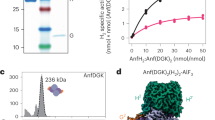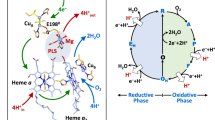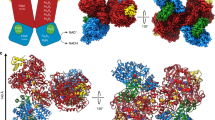Abstract
Cytochrome cd1 nitrite reductase (cd1) from Paracoccus pantotrophus is a respiratory enzyme capable of using nitrite, hydroxylamine and oxygen as electron accepting substrates. Structural studies have shown that when the enzyme is reduced there is a change in the axial ligation of both hemes, which has been proposed to form part of the catalytic cycle. Here we report the use of a physiological electron donor, pseudoazurin, to investigate the relationship between heme ligation and catalysis. A combination of visible absorption and electron paramagnetic resonance spectroscopies reveals the formation of a catalytically competent state of oxidized cd1 with ‘switched’ axial ligands immediately after complete reoxidation of reduced cd1 with hydroxylamine. This activated conformer returns over 20 min at 25 °C to the state previously observed for oxidized ‘as isolated’ cd1, which is catalytically inactive towards the same substrates.
This is a preview of subscription content, access via your institution
Access options
Subscribe to this journal
Receive 12 print issues and online access
$189.00 per year
only $15.75 per issue
Buy this article
- Purchase on Springer Link
- Instant access to full article PDF
Prices may be subject to local taxes which are calculated during checkout




Similar content being viewed by others
References
Rainey, F.A., et al. Int. J. Syst. Bact. 49, 645–651 (1999).
Yamanka, T., Ota, A. & Okunuki, K. Biochim. Biophys. Acta. 53, 294–308 (1961).
Berks, B.C., Ferguson, S.J., Moir, J.W.B. & Richardson, D.J. Biochim. Biophys. Acta. 1232, 97–173 (1995).
Koppenhöfer, A., Little. R.H., Lowe, D.J., Ferguson, S.J. & Watmough, N.J. Biochemistry 39, 4028–4036 (2000).
Kucera, I. & Skládal, P. Gen. Physiol. Biophys. 9, 501–517 (1990).
Singh, J. Biochim. Biophys. Acta. 333, 28–36 (1973).
Fülöp, V., Moir, J.W.B., Ferguson, S.J. & Hajdu, J. Cell 81, 369–377 (1995).
Page, C.C., Moser, C.C., Chen, X. & Dutton, P.L. Nature 402, 47–52 (1999).
Silvestrini, M.C., Tordi, M.G., Musci, G. & Brunori, M. J. Biol. Chem. 265, 11783–11787 (1990).
Cheesman, M.R., et al. Biochemistry 36, 16267–16276 (1997).
Williams, P.A., et al. Nature 389, 406–412 (1997).
Nurizzo, D., et al. Structure 5, 1157–1171 (1997).
Nurizzo, D., et al. Biochemistry 37, 13987–13996 (1998).
Zumft, W.G. Microbiol. Mol. Biol. Rev. 61, 533–616 (1997).
Richardson, D.J. & Watmough, N.J. Curr. Opin. Chem. Biol. 3, 207–219 (1999).
Pearson, I.V.D. Phil. Thesis, Cloning, mutagenesis and expression studies of the pazS gene, encoding pseudoazurin from Paracoccus denitrifians. University of Oxford (2000).
Moir, J.W.B., Baratta, D., Richardson, D.J. & Ferguson, S.J. Eur. J. Biochem. 212, 377–385 (1993).
Koppenhöfer, A., Turner, K.L., Allen, J.W.A., Chapman, S.K. & Ferguson, S.J. Biochemistry 39, 4234–4249 (2000).
Kobayashi, K., Koppenhöfer, A., Ferguson, S.J. & Tagawa, S. Biochemistry 36, 13611–13616 (1997).
Moore, G.R. & Pettigrew, G.W. (eds). Cytochromes c: evolutionary, structural and physicochemical aspects (Springer-Verlag, Berlin; 1990).
Williams, P.A., et al. Nature Struct. Biol. 2, 975–982 (1995).
Gadsby, P.M.A. & Thomson, A.J. J. Am. Chem. Soc. 112, 5003–5011 (1990).
Walker, F.A. Coord. Chem. Rev. 186, 471–534 (1999).
Muhoberac, B.B. & Wharton, D.C. J. Biol. Chem. 258, 3019–3027 (1983).
Leung, Y.C., et al. Biochem. J. 321, 699–705 (1997).
Kraulis, P.J. J. Appl. Crystallogr. 24, 946–950 (1992).
Merrit, E.A. & Bacon D.J. Meth. Enzymol. 277, 505–524 (1997).
Acknowledgements
We would like to thank A. Koppenhöfer for his contribution to the early stages of this work. This work was supported by grants from the BBSRC and the Commission of the European Communities to S.J.F. and the Wellcome Trust to N.J.W. JWAA is grateful to the EPSRC for a studentship. This is a contribution from the Oxford Centre for Molecular Sciences, which is supported by the BBSRC, EPSRC and MRC.
Author information
Authors and Affiliations
Corresponding authors
Rights and permissions
About this article
Cite this article
Allen, J., Watmough, N. & Ferguson, S. A switch in heme axial ligation prepares Paracoccus pantotrophus cytochrome cd1 for catalysis. Nat Struct Mol Biol 7, 885–888 (2000). https://doi.org/10.1038/82821
Received:
Accepted:
Issue Date:
DOI: https://doi.org/10.1038/82821
This article is cited by
-
Tuning the electrical conductance of metalloporphyrin supramolecular wires
Scientific Reports (2016)
-
Kinetics studies of the superoxide-mediated electron transfer reactions between rubredoxin-type proteins and superoxide reductases
JBIC Journal of Biological Inorganic Chemistry (2006)



